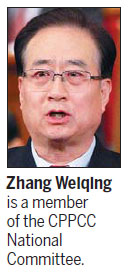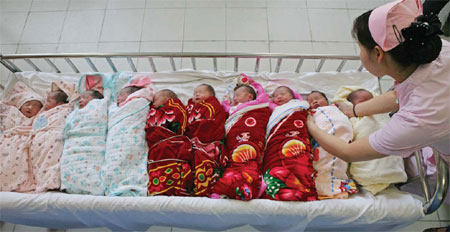Family planning policy may be eased
Updated: 2012-11-30 06:45
By Zhao Yanrong (China Daily)
|
||||||||
|
A nurse takes care of five sets of twin babies at a hospital in Xiangyang, Hubei province. Proposed changes to the family planning policy may allow more families to have a second child. Gong Bo / for China Daily |
Pensions and labor force feel the increasing pressure of demographic shifts
China is considering relaxing its family-planning policies as the problems of a graying society loom.
Changes being mulled include encouraging more families to have a second child, winding back a policy in force for 30 years that allows most families to have only one child.
The National Population and Family Planning Commission and other population research institutes have made submissions on policy changes to the government, says Zhang Weiqing, director of the Population, Resources and Environment Committee of the National Committee of the Chinese People's Political Consultative Conference.
"China's population policy has always taken into account demographic changes, but any fine-tuning to the policy needs to be gradual and consider the situation in different areas," Zhang says.
At present urban couples are less likely than their rural counterparts to have a second child. Only parents who are themselves an only child are allowed to have a second child. Under the proposed changes, couples will be able to have a second child even if one of them is an only child.
Urban couples would be the biggest beneficiaries of such a policy change, Zhang says. Such a change might first be introduced in more economically productive regions that face greater demographic challenges, he says.
The size of China's population has been one of the most important spurs to its rapid growth over the past three decades, providing a massive, low-cost workforce. However, after years of family planning aimed at curbing population growth, the country is losing its demographic dividend.

When China's sixth census was taken in 2010, children accounted for only 16.6 percent of the population, almost 6 percentage points lower than in the census 10 years earlier. The same two censuses showed the number of those aged 65 rising two percentage points, to 8.9 percent.
With fewer young workers and more people in retirement, the trend toward lower economic growth will continue, says Cai Fang, director of the Institute of Population and Labor Economics of the Chinese Academy of Social Sciences.
By the end of 2020, those of working age will fall by as much as 30 million, and fewer workers will result in a rising dependency ratio, lower savings ratios and diminishing returns and, eventually, slower economic development, he says.
Cai estimates that GDP growth will average 7.2 percent over the life of the 12th Five-Year Plan (2011-15) and 6.1 percent over the five years of the next plan.
A labor shortage will have a particularly dramatic impact on manufacturing in urbanized and industrialized regions, such as the Yangtze River Delta in the east and the Pearl River Delta in the south.
A report by the China Development Research Foundation on population change and its effects shows that with 220 million migrant workers throughout the country, Chinese factories can still not recruit enough people.
"About 67.3 percent of laborers are from rural areas, but less than a quarter of the rural workers are under 30, and there are fewer new young migrant workers to replenish the numbers," the report says.
The report also says the annual growth of China's population has been falling, and was 0.57 percent in the first decade of the 21st century, compared with 1.07 percent in the previous decade. The national fertility rate (the average number of children a woman has during her lifetime) is below 1.5, compared with a replacement level of 2.1, and well below the rate of other developing countries.
"Chinese demographic dividends will end by the end of 2013, and China will enter an era that becomes aged before turning wealthy," Cai says.
"Becoming aged before becoming wealthy means the countries with incomes on a par with China's are actually younger than us; and the countries with demographic characteristics similar to China's are in fact wealthier than us."
China's population will start falling in about 10 years, he says.
If more Chinese families had a second child, that would not only replenish the workforce but also provide an important support to society as the population ages, he says. This would include the elderly being properly taken care of and the flow of money into pension funds increasing.
Du Peng, director of the Gerontology Institute at Renmin University of China, says that by the end of 2050, of the five BRICS nations - Brazil, Russia, India, China, and South Africa - China would face the most pressing problem with aging.
"The financial burden of paying out more in pensions while fewer people work will slow economic growth. It will also challenge our social security system."
Du says there are 178 million old people in China, and the number will rise 8 million a year for the coming three years. As a social security system offering pensions gets into full swing, the total number of aged people covered will rise from almost 200 million in 2015 to more than 450 million in 2050.
At the end of 2010 the amount of money in China's individual pension accounts was put at 1.9 trillion yuan ($305 billion; 235 billion euros), but little more than a 10th of that was available, the Global Pension Fund Research Center at the Chinese Academy of Social Sciences says.
"The number of elderly people receiving social security payments is increasing, but proportionately the number of those entering the labor market is falling," Du says.
"How to maintain the dynamic balance of the social security fund to cover spending is a huge challenge."
The current Chinese family planning policy was introduced in the late 1970s and was strictly carried out in 1980, aiming to curb problems resulting from overpopulation, such as the great pressure on resources and society.
zhaoyanrong@chinadaily.com.cn
(China Daily 11/30/2012 page3)

 Relief reaches isolated village
Relief reaches isolated village
 Rainfall poses new threats to quake-hit region
Rainfall poses new threats to quake-hit region
 Funerals begin for Boston bombing victims
Funerals begin for Boston bombing victims
 Quake takeaway from China's Air Force
Quake takeaway from China's Air Force
 Obama celebrates young inventors at science fair
Obama celebrates young inventors at science fair
 Earth Day marked around the world
Earth Day marked around the world
 Volunteer team helping students find sense of normalcy
Volunteer team helping students find sense of normalcy
 Ethnic groups quick to join rescue efforts
Ethnic groups quick to join rescue efforts
Most Viewed
Editor's Picks

|

|

|

|

|

|
Today's Top News
Chinese fleet drives out Japan's boats from Diaoyu
Health new priority for quake zone
Inspired by Guan, more Chinese pick up golf
Russia criticizes US reports on human rights
China, ROK criticize visits to shrine
Sino-US shared interests emphasized
China 'aims to share its dream with world'
Chinese president appoints 5 new ambassadors
US Weekly

|

|







